Large-Scale High-Accuracy and High-Efficiency Phase Plate Machining
Abstract
:1. Introduction
2. Experimental Design and Methods
2.1. Femtosecond Laser Photolithography System
2.2. Multilevel Phase Mask Design Method
2.3. Cleaning and Etching Process
3. Fabrication Characterization and Functional Demonstration
3.1. Fabrication Characterization
3.2. Functional Demonstrating
3.3. Efficient Preparation of Large-Scale DOEs
4. Conclusions
Author Contributions
Funding
Data Availability Statement
Conflicts of Interest
References
- Weiner, A.M. Femtosecond pulse shaping using spatial light modulators. Rev. Sci. Instrum. 2000, 71, 1929–1960. [Google Scholar] [CrossRef]
- Ostrovsky, A.S.; Rickenstorff-Parrao, C.; Arrizón, V. Generation of the “perfect” optical vortex using a liquid-crystal spatial light modulator. Opt. Lett. 2013, 38, 534–536. [Google Scholar] [CrossRef] [PubMed]
- Cheng, Y.; Sugioka, K.; Midorikawa, K.; Masuda, M.; Toyoda, K.; Kawachi, M.; Shihoyama, K. Control of the cross-sectional shape of a hollow microchannel embedded in photostructurable glass by use of a femtosecond laser. Opt. Lett. 2003, 28, 55–57. [Google Scholar] [CrossRef]
- He, F.; Xu, H.; Cheng, Y.; Ni, J.L.; Xiong, H.; Xu, Z.Z.; Sugioka, K.; Midorikawa, K. Fabrication of microfluidic channels with a circular cross section using spatiotemporally focused femtosecond laser pulses. Opt. Lett. 2010, 35, 1106–1108. [Google Scholar] [CrossRef]
- Minovich, A.E.; Miroshnichenko, A.E.; Bykov, A.Y.; Murzina, T.V.; Neshev, D.N.; Kivshar, Y. Functional and nonlinear optical metasurfaces. Laser Photonics Rev. 2015, 9, 195–213. [Google Scholar] [CrossRef]
- Chen, S.M.; Cai, Y.; Li, G.X.; Zhang, S.; Cheah, K.W. Geometric metasurface fork gratings for vortex—Beam generation and manipulation. Laser Photonics Rev. 2016, 10, 322–326. [Google Scholar] [CrossRef]
- Stern, L.; Bopp, D.G.; Schima, S.A.; Maurice, V.N.; Kitching, J.E. Chip-scale atomic diffractive optical elements. Nat. Commun. 2019, 10, 3156. [Google Scholar] [CrossRef]
- Sabatyan, A.; Fathi, B. High-efficiency arrays of any desired optical beams using modified grating-based elements. Opt. Quant. Electron. 2018, 50, 1–10. [Google Scholar] [CrossRef]
- Flamm, D.; Grossmann, D.G.; Jenne, M.; Zimmermann, F.; Kleiner, J.; Kaiser, M.; Hellstern, J.; Tillkorn, C.; Kumkar, M. Beam shaping for ultrafast materials processing. In Laser Resonators, Microresonators, and Beam Control XXI, Proceeding of the SPIE LASER, San Francisco, CA, USA, 2–7 February 2019; SPIE: Bellingham, WA, USA, 2019; Volume 10904, pp. 130–146. [Google Scholar]
- Forbes, A. Structured Light from Lasers. Laser Photonics Rev. 2019, 13, 1900140. [Google Scholar] [CrossRef]
- He, F.; Yu, J.J.; Tan, Y.X.; Chu, W.; Zhou, C.H.; Cheng, Y.; Sugioka, K. Tailoring femtosecond 1.5-μm Bessel beams for manufacturing high-aspect-ratio through-silicon vias. Sci. Rep. 2017, 7, 40785. [Google Scholar] [CrossRef]
- Kim, D.; Keesling, A.; Omran, A.; Levine, H.; Bernien, H.; Greiner, M.; Lukin, M.D.; Englund, D.R. Large-scale uniform optical focus array generation with a phase spatial light modulator. Opt. Lett. 2019, 44, 3178–3181. [Google Scholar] [CrossRef] [PubMed]
- Xu, C.; Pang, H.; Cao, A.; Deng, Q. Alternative design of binary phase diffractive optical element with non-π phase difference. Appl. Sci. 2021, 11, 1116. [Google Scholar] [CrossRef]
- He, C.; Shen, Y.J.; Forbes, A. Towards higher-dimensional structured light. Light Sci. Appl. 2022, 11, 205. [Google Scholar] [CrossRef]
- Yang, Y.J.; Ren, Y.X.; Chen, M.Z.; Arita, Y.; Rosales-Guzmán, C. Optical trapping with structured light: A review. Adv. Photon. 2021, 3, 034001. [Google Scholar] [CrossRef]
- Barlev, O.; Golub, M.A. Multifunctional binary diffractive optical elements for structured light projectors. Opt. Express 2018, 26, 21092–21107. [Google Scholar] [CrossRef]
- Khonina, S.N.; Kotlyar, V.V.; Skidanov, R.V.; Soifer, V.A.; Jefimovs, K.; Simonen, J.; Turunen, J. Rotation of microparticles with Bessel beams generated by diffractive elements. J. Mod. Opt. 2004, 51, 2167–2184. [Google Scholar] [CrossRef]
- Shkuratova, V.; Kostyuk, G.; Sergeev, M.; Zakoldaev, R.; Yakovlev, E.; Medvedev, O. Rapid fabrication of spiral phase plate on fused silica by laser-induced microplasma. Appl. Phys. B 2020, 126, 61. [Google Scholar] [CrossRef]
- Poleshchuk, A.G.; Korolkov, V.P.; Nasyrov, R.K. Diffractive optical elements: Fabrication and application. In Proceedings of the 7th International Symposium on Advanced Optical Manufacturing and Testing Technologies: Design, Manufacturing, and Testing of Micro-and Nano-Optical Devices and Systems, Harbin, China, 26–29 April 2014; Volume 9283, p. 928302. [Google Scholar]
- Stankevič, V.; Karosas, J.; Gečys, P. Fabrication of a multilevel Fresnel axicon deep in fused silica by femtosecond laser machining. Opt. Lett. 2023, 48, 4404–4407. [Google Scholar] [CrossRef]
- Luo, S.W.; Chang, T.L.; Tsai, H.Y. Fabrication of diffractive microlens array by femtosecond laser-assisted etching process. Microelectron. Eng. 2012, 98, 448–452. [Google Scholar] [CrossRef]
- Guo, R.; Xiao, S.Z.; Zhai, X.M.; Li, J.W.; Xia, A.D.; Huang, W.H. Micro lens fabrication by means of femtosecond two photon photopolymerization. Opt. Express 2006, 14, 810–816. [Google Scholar] [CrossRef]
- Chen, J.M.; Liu, Z.X.; Song, L.B.; Sun, C.; Wang, G.H.; Cheng, Y. Ultra-high-speed high-resolution laser lithography for lithium niobate integrated photonics. In Frontiers in Ultrafast Optics: Biomedical, Scientific, and Industrial Applications XXIII, Proceeding of the SPIE LASE, San Francisco, CA, USA, 28 January–3 February 2023; SPIE: Bellingham, WA, USA, 2023; Volume 12411, pp. 41–50. [Google Scholar]
- Swanson, G.J.; Veldkamp, W.B. Diffractive optical elements for use in infrared systems. Opt. Eng. 1989, 28, 605–608. [Google Scholar] [CrossRef]
- Vázquez, R.M.; Eaton, S.M.; Ramponi, R.; Cerullo, G.; Osellame, R. Fabrication of binary Fresnel lenses in PMMA by femtosecond laser surface ablation. Opt. Express 2011, 19, 11597–11604. [Google Scholar] [CrossRef]
- Buralli, D.A.; Morris, G.M.; Rogers, J.R. Optical performance of holographic kinoforms. Appl. Opt. 1989, 28, 976–983. [Google Scholar] [CrossRef] [PubMed]
- Leach, J.; Gibson, G.M.; Padgett, M.J.; Esposito, E.; McConnell, G.; Wright, A.J.; Girkin, J.M. Generation of achromatic Bessel beams using a compensated spatial light modulator. Opt. Express 2006, 14, 5581–5587. [Google Scholar] [CrossRef]
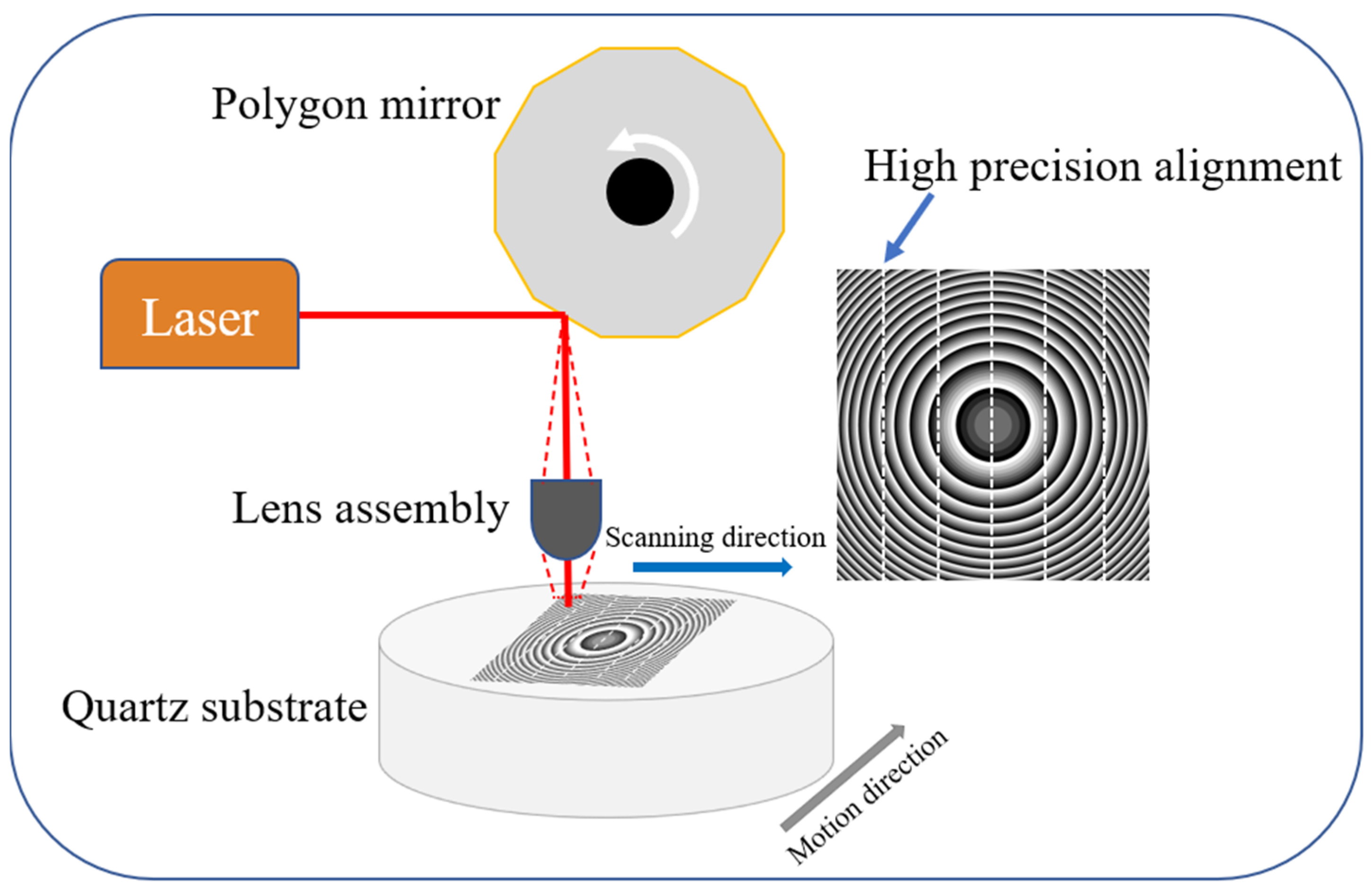

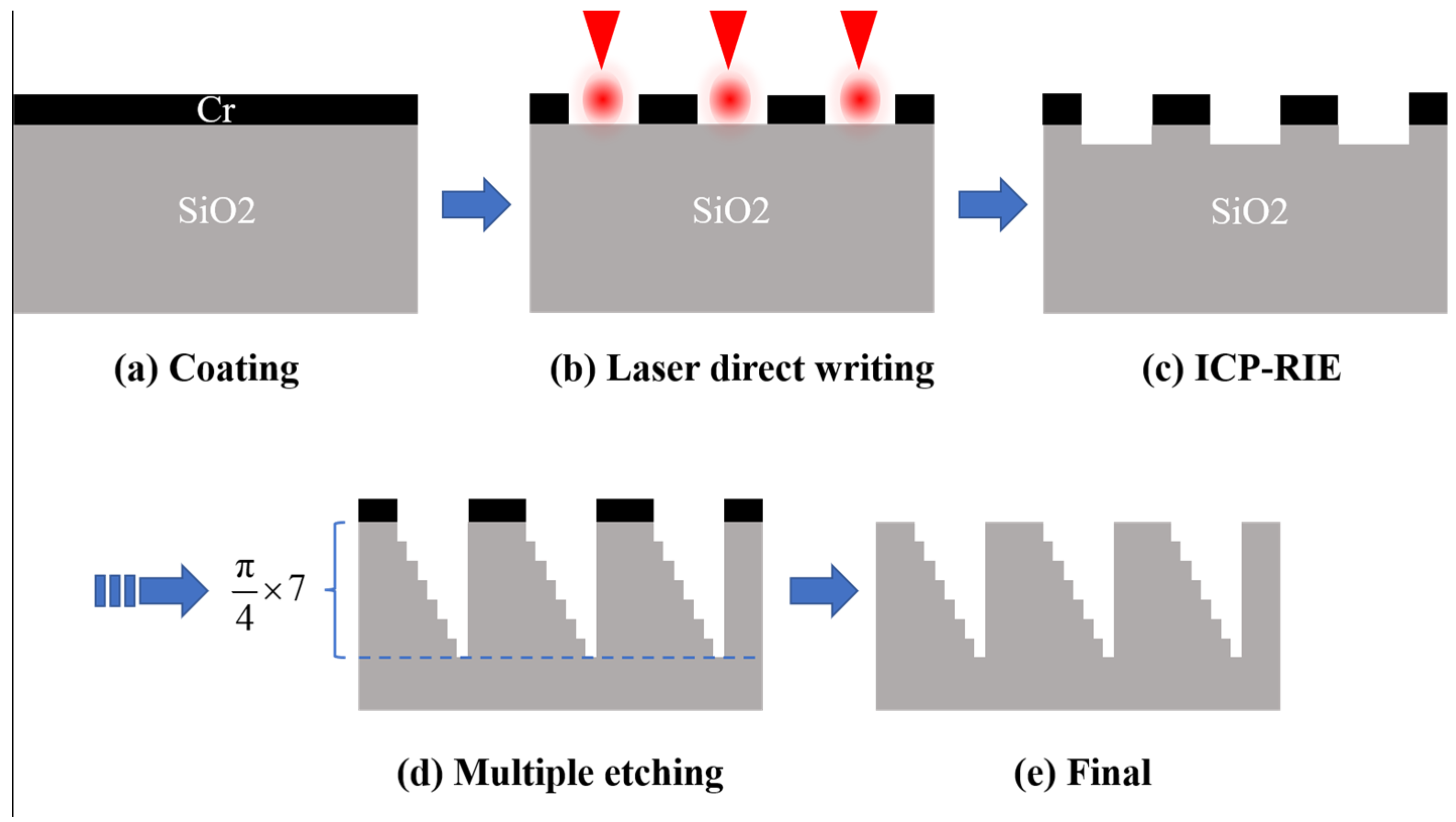

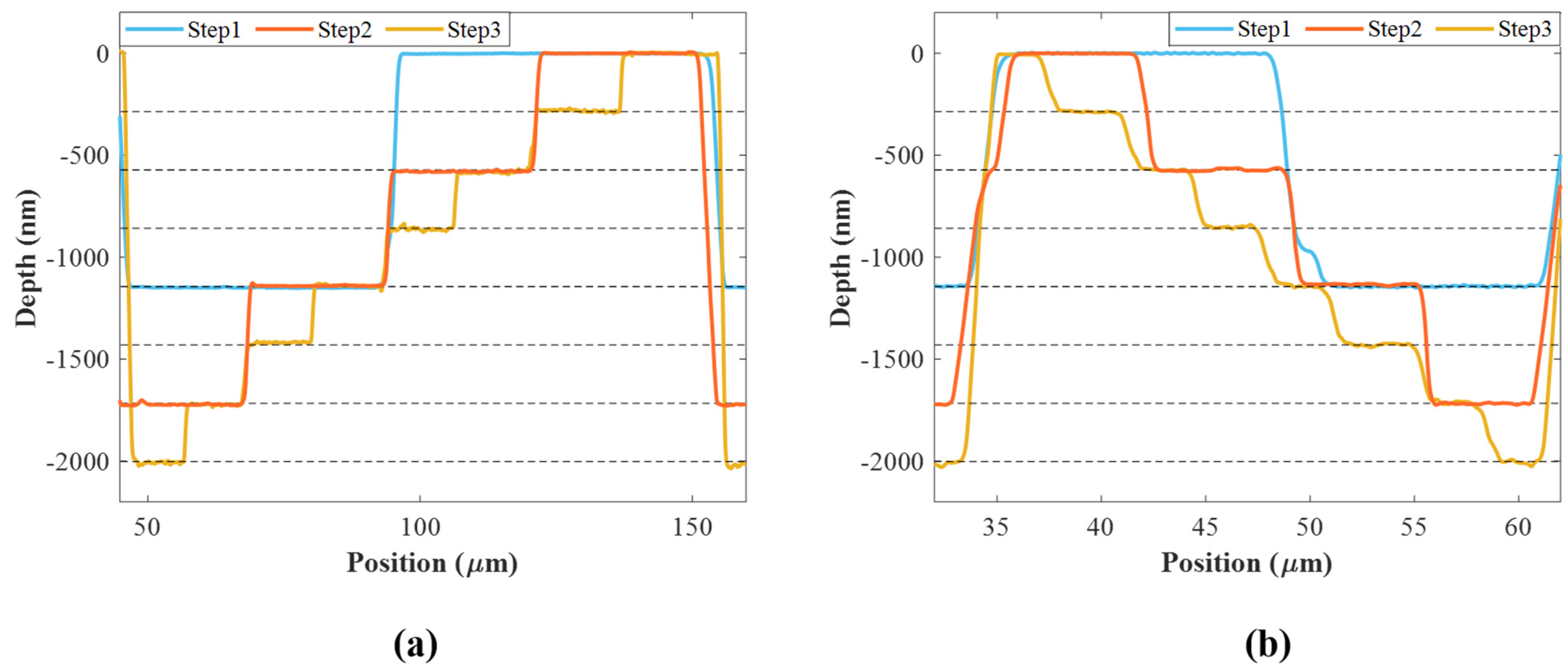
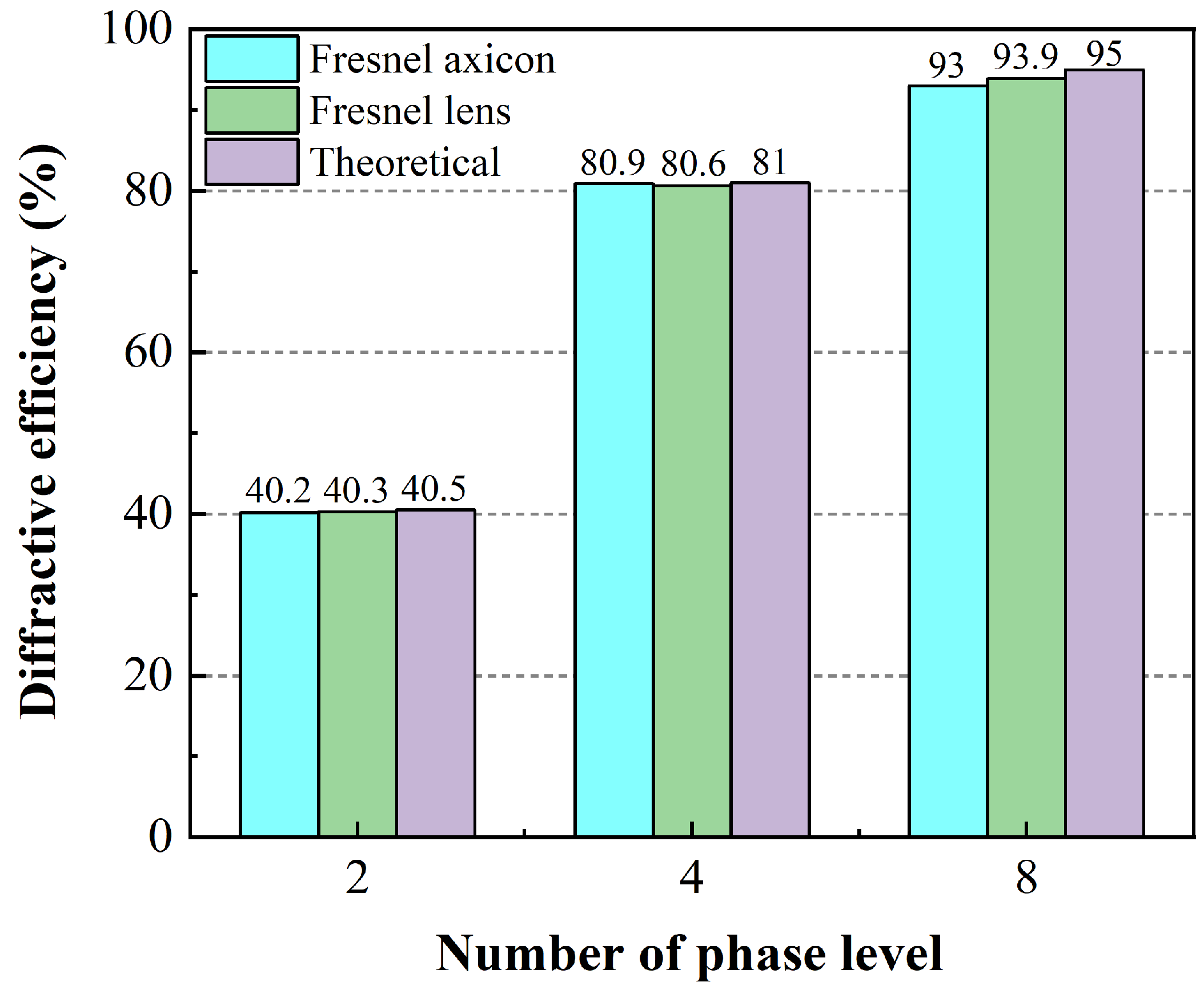
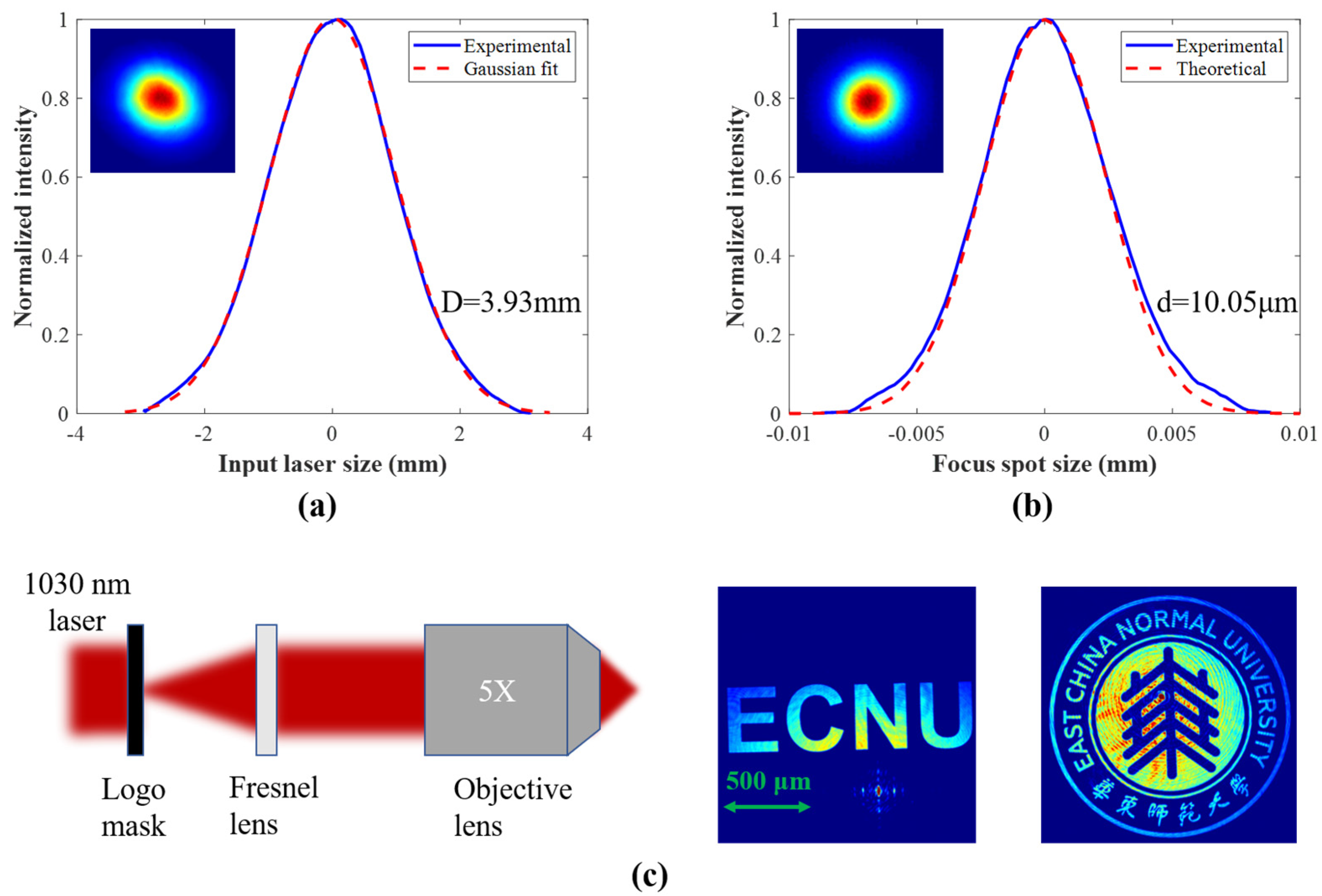
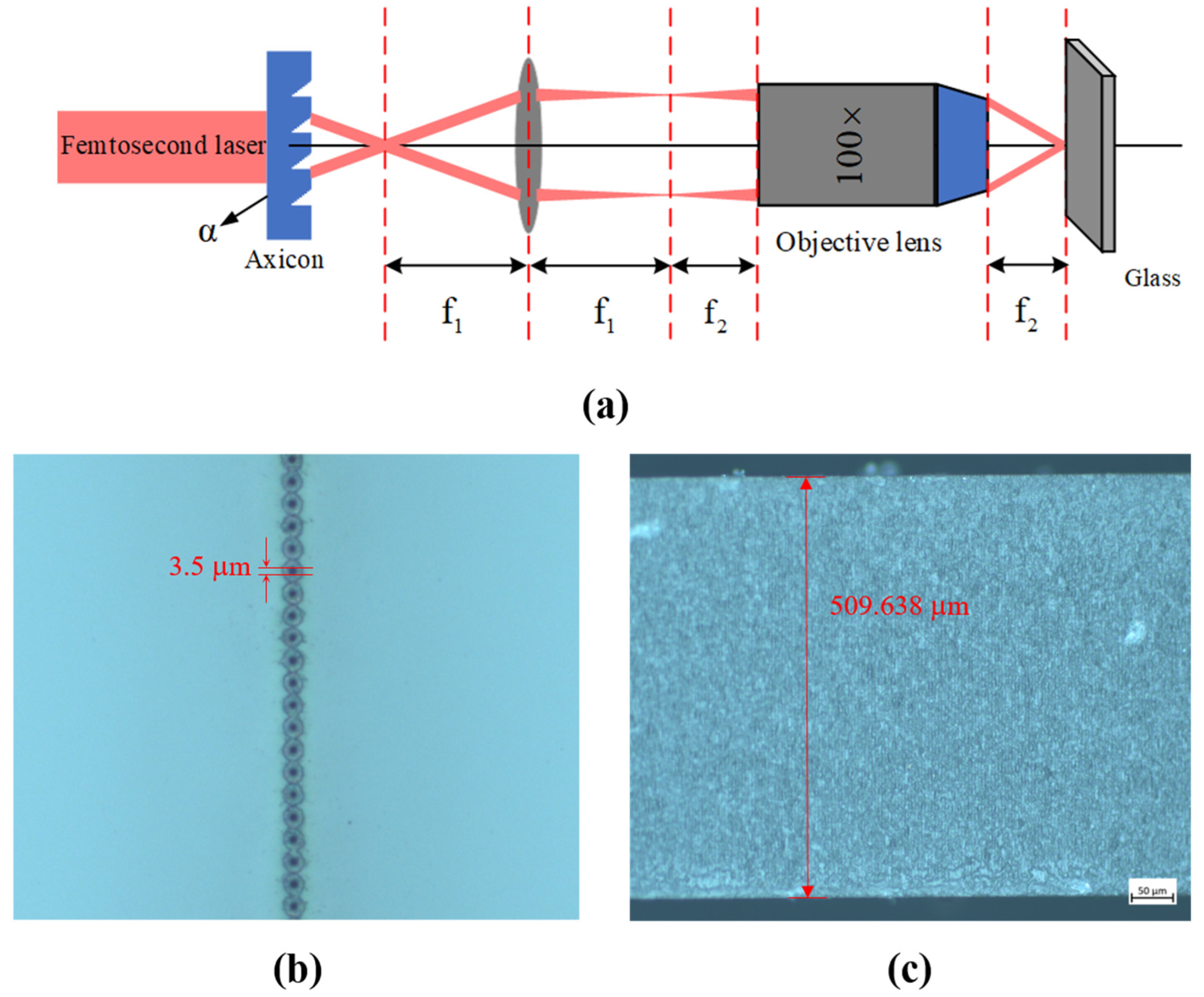
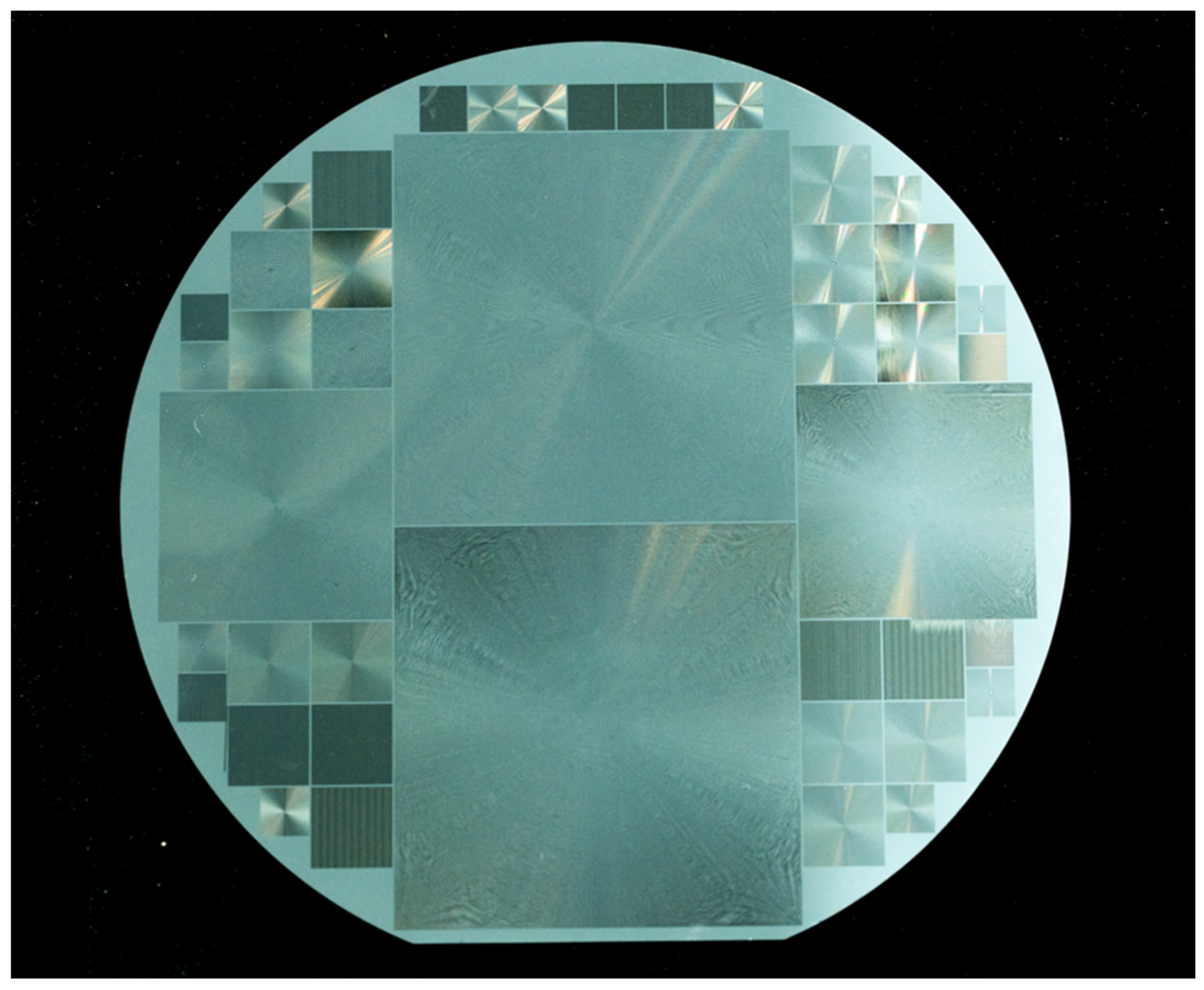
Disclaimer/Publisher’s Note: The statements, opinions and data contained in all publications are solely those of the individual author(s) and contributor(s) and not of MDPI and/or the editor(s). MDPI and/or the editor(s) disclaim responsibility for any injury to people or property resulting from any ideas, methods, instructions or products referred to in the content. |
© 2024 by the authors. Licensee MDPI, Basel, Switzerland. This article is an open access article distributed under the terms and conditions of the Creative Commons Attribution (CC BY) license (https://creativecommons.org/licenses/by/4.0/).
Share and Cite
Wang, G.; Liu, Z.; Song, L.; Guan, J.; Chen, W.; Liu, J.; Chen, J.; Wang, M.; Cheng, Y. Large-Scale High-Accuracy and High-Efficiency Phase Plate Machining. Nanomaterials 2024, 14, 1563. https://doi.org/10.3390/nano14191563
Wang G, Liu Z, Song L, Guan J, Chen W, Liu J, Chen J, Wang M, Cheng Y. Large-Scale High-Accuracy and High-Efficiency Phase Plate Machining. Nanomaterials. 2024; 14(19):1563. https://doi.org/10.3390/nano14191563
Chicago/Turabian StyleWang, Guanhua, Zhaoxiang Liu, Lvbin Song, Jianglin Guan, Wei Chen, Jian Liu, Jinming Chen, Min Wang, and Ya Cheng. 2024. "Large-Scale High-Accuracy and High-Efficiency Phase Plate Machining" Nanomaterials 14, no. 19: 1563. https://doi.org/10.3390/nano14191563






